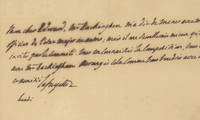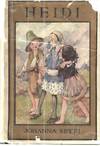
In a Letter to Edward Livingston From New York on His Great Tour in June 1825, Lafayette Makes Arrangements for His Reception Following the Laying of the Bunker Hill Monument Cornerstone: A rare letter written from the US planning this epic tour, one of only a handful we found having sold going back decades and the first we have carried
- Used
- Signed
- Condition
- See description
- Seller
-
Ardmore, Pennsylvania, United States
Payment Methods Accepted
About This Item
He wonders whether he should bring a delegation of surviving military staff from the Revolutionary War
In 1824, with the nation prosperous, exuberant and in the midst of the Era of Good Feelings, nostalgia was strong for the Revolutionary War generation that had made the U.S. independent and was now passing rapidly from the scene. President James Monroe invited the Marquis de Lafayette to visit the United States, and accompanied by his son, George Washington Lafayette, the old soldier visited all 24 states of the Union. Everywhere he was received with great enthusiasm and excitement. On August 16, he disembarked in New York and was escorted from the Battery in a carriage drawn by four white horses to City Hall. Then, while in his carriage and placed on a barge with his horses, Lafayette was taken to Brooklyn and cheered by thousands. In the crowd was a 15-year-old boy named Walt Whitman who never forgot that exciting moment. When he arrived in Philadelphia on September 29, Lafayette was greeted by a long parade that included 160 Revolutionary War veterans drawn in large wagons. A few days later, the Marquis visited Brandywine battlefield where he had been shot in the leg. In October, he visited the tomb of Washington at Mount Vernon, then left for Yorktown, where he was greeted by Chief Justice John Marshall. After that, he stayed with Thomas Jefferson at Monticello. At a banquet at the University of Virginia at Charlottesville, the Marquis was seated between Jefferson and James Madison. On November 23, Lafayette dined in the White House with President and Mrs. Monroe. He would remain based in Washington until March 1825.
At this point his tour took him to the deep south and up the Mississippi and Ohio to the North. In St. Louis, a newly established city in Missouri, where Lewis and Clark began their expedition, Lafayette learned about the American wilderness and frontier life. With Governor Clark as his escort, Lafayette witnessed many wild animals, including grizzly bears that roamed the Missouri plains. After heading North, Lafayette wound through the state of Pennsylvania and into New York.
Edward Livingston was an influential figure in the drafting of the Louisiana Civil Code of 1825, a civil code based largely on the Napoleonic Code. Livingston represented both New York and then Louisiana in Congress and served as the U.S. Secretary of State from 1831 and Minister to France from 1833 to 1835 under President Andrew Jackson. He was also the 46th mayor of New York City.
He was also the younger brother of Robert Livingston. Once Thomas Jefferson became president on March 4, 1801, he appointed Robert U.S. minister to France. Serving from 1801 to 1804, Livingston negotiated the Louisiana Purchase.
The Life of Edward Livingston is a biography written by Charles Havens Hunt. In it, Hunt notes that for 60 years, Lafayette referred to Edward Livingston as ""My dear Edward."" It was a lifelong friendship made closer due to the latter's time in France, connections to the French, and mastery of the language. Edward was fluent in French.
Joseph T. Buckingham was an acquaintance of both Lafayette and Livingston. He would in the 1830s serve as President of the Bunker Hill Monument Association, which finished the monument. At the time of Lafayette's tour he was a writer and editor in Massachusetts. He was also an event host for the Lafayette Tour.
On June 12, Lafayette arrived in Albany and paid a visit to the notables there before continuing East.
On June 17, he laid the cornerstone of the Bunker Hill Monument during celebration of the 50th anniversary of the Battle of Bunker Hill in Charlestown, Boston, Massachusetts, accompanied by Daniel Webster, who gave a rousing speech.
And on June 20, 1825, the Massachusetts Mechanics Association hosted a banquet at the Marlboro Hotel, where Lafayette stayed. Joseph T. Buckingham, the host of the event, invoked Paul Revere’s memory while honoring Lafayette: “The Memory of Paul Revere – a Boston Mechanic, who wrought zealously and cheerfully in the great work of Liberty.” The Marlboro Hotel was located on the corner of Tremont and Park Streets, and was later demolished to make room for the nation’s first subway station, Park Street Station. That evening, Lafayette attended the production of “Charles the Second,” a play by American playwright John Howard Payne.
Lafayette's receptions often included delegations of surviving soldiers and officers from the general staff that had served with Lafayette and other dignitaries.
Autograph letter signed, in French, no date (""Monday"") or place but evidently New York State, approximately June 12, 1825, to Edward Livingston, whom he referred to in his correspondence as ""My Dear Edward, Mr. [evidently Joseph T.] Buckingham has asked me to lead with me some officers of the general staff or others; but it seems to me better that they might be invited by the committee. You are familiar with its composition; you are connected with Mr. Buckingham. Arrange this as you would like with him.""
Reviews
(Log in or Create an Account first!)
Details
- Bookseller
- The Raab Collection
(US)
- Bookseller's Inventory #
- 30887
- Title
- In a Letter to Edward Livingston From New York on His Great Tour in June 1825, Lafayette Makes Arrangements for His Reception Following the Laying of the Bunker Hill Monument Cornerstone
- Book Condition
- Used
- Date Published
- 1825
Terms of Sale
The Raab Collection
10 day return guarantee, with full refund excluding shipping costs for up to 10 days after delivery if an item is returned in original condition
About the Seller
The Raab Collection
About The Raab Collection
Glossary
Some terminology that may be used in this description includes:
- New
- A new book is a book previously not circulated to a buyer. Although a new book is typically free of any faults or defects, "new"...

